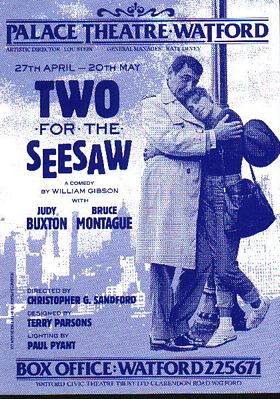TWO FOR THE SEESAW by
William Gibson
Venue: Watford Palace 1989
Director: Christopher G Sandford
Venue: Watford Palace 1989
Director: Christopher G Sandford

Cast
| Jerry Ryan | Bruce Montague |
| Gittel Mosca | Judy Buxton |
Review
A doomed affair between two lonely people in New York of the 1950s makes you leave the Palace Theatre with a lump in your throat, but it quickly dissolves. This stage affair is different. It's treating the experience as a positive event in two people's lives. You leave the theatre smarting from the inevitable split, but realising that these two incompatible people are both richer, happier and wiser for the experience. And better equipped to carry on with the rest of their lives.It is this treatment and the performances by Judy Buxton and Bruce Montague that make William Gibsonís Two For The Seesaw special and timeless, although played in period setting at the Palace. The dialogue and the wit are undramatically ordinary, the drama is within the people and in reaction to each other. Loneliness and love tie a temporary bond between Jerry (Bruce Montague), a lawyer from Omaha, who has sought the bright lights of New York as an escape from a suffocating attack of supportive wife - she even put him through college and installed him in father's firm - and Gittel (Judy Buxton), streetwise, but an insecure and vulnerable second-rate dancer. He is at a crossroads, she is a victim of her own insecurity and generosity, the kind of person other people take advantage of. In the process of their affair, an attempt at creating a lasting relationship, their different attitudes prove a positive plaster on cracks in their personalities, but it also becomes increasingly clear that he is a coward, who needs to be led, and her pride will not allow her to take charge, her insecurity cannot ignore the shadow his ex-wife throws between them. The 1200 miles of telephone cable between New York and Omaha becomes a snake in their relationship.Initially Christopher Sandfordís production suffers a personality crisis. Jerry could have been an escapee gangster from Chicago, judged by his dress, speech and spartan temporary accommodation. Gittel, by contrast, appears more scatty than streetwise. Quite possibly the effect would be different on an American audience, who might more easily recognise the types. As the play develops, however, the characters become clear, with Judy Buxton explicitly portraying the growing confidence of Gittel. Bruce Montague struggles with the accent and consequently mumbles some of his lines, but his personality so suits the considerable confirmed husband-type, it does nothing to spoil the joint performance which takes you all the way to an emotional climax you didn't expect to reach at the outset.Terry Parsonsí transformation of the Palace stage is a slice of New York, complete with the inside of two fully equipped bedsits and large chunks of exterior scenario with skyscrapers and neon signs. It gives the play such atmosphere and interest it deserved a round of applause of its own.